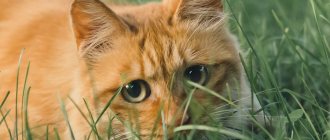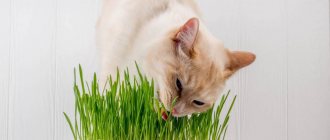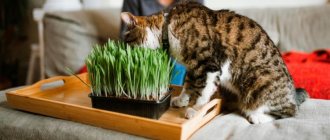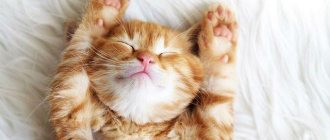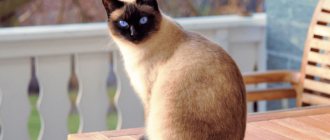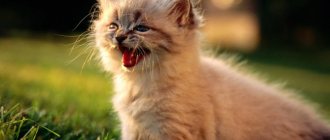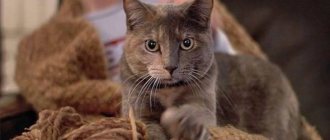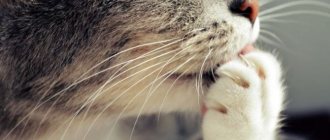How is grass beneficial for cats?
Plants characterized by hard leaves are eaten by kisuli to cleanse the stomach. It may contain indigestible food remains (for example, bones), or wool after licking the fur coat. The hard leaves begin to irritate the gastric mucosa, quickly causing vomiting. If there is enough fiber in the cat's diet, then the hair can come out naturally - through the intestines. And then there will be no vomiting after eating greens.
Other and no less important beneficial properties of weed include:
- Rich in nutrients. Greens are high in fiber and vitamins. However, it all depends on the type of plant that the cat eats. Some herbs pass through “transit”, helping the kitty only to cleanse the stomach.
- Relaxation. When a cat eats greens, she stops being nervous or irritated.
- Presence of folic acid. The herbs adored by kitties contain this vitamin B9. The vitamin promotes the growth and healthy development of the body, saturates the blood with oxygen, and makes the pet active and inquisitive.
- It's simply delicious. Some cats eat greens just because they like the taste.
Feed cats hay
Have you noticed how cats sometimes gnaw flowers growing on windowsills, or bite bouquets of dried flowers, or gnaw brooms? Well, of course we noticed! Why, why do they do this? What do you think: is this pampering, a disease, or a normal physiological need? I answer right away: this is a natural physiological need of cats!
The fact is that the cat’s digestive tract is adapted to accept wool, feathers, bones , since its ancestors ate rodents and birds, eating them with wool, bones and feathers. From the stomach, the useful component of the food eaten entered the intestines, and the cat regurgitated the undigested components (fur, feathers), naturally, with gastric juice! And many domestic cats maintain this food processing regime. From time to time, their body requires taking some kind of rough food (for example, grass) to “cleanse” the stomach, or rather, to normalize its functioning. During the molting period, a cat, when licking its skin, swallows a lot of hair and has a need to eat grass to speed up the regurgitation process. Some people mistakenly believe that cats eat grass as a source of vitamins. No, no and NO! As for vitamins, under natural conditions, the body of a healthy cat itself produces all the vitamins it needs, which do not enter its body along with the meat of its victims.
Cats do not eat all the first plants they come across, but only cereal grasses (that is, those in which a spikelet or something like a spikelet is formed during the period of seed maturation), grasses like sedge. Caring owners grow oats for their cats, which quickly produces lush green grass. By the way, oats are the most preferred plant for many animals. For example, bears eat oats with pleasure, especially during the period of milky-wax ripeness. And my picky cat sometimes happily eats burnt whole grain oatmeal without any seasoning.
To successfully grow oat grass , you should cover the jar in which the oats are sown with a plastic bag, like a cap. Firstly, something like a mini-greenhouse is formed, in which the oats grow faster. Secondly, the cat will not prematurely pull out unrooted plants and will not ruin your work. Once the grass has taken root and grown to a size that allows your cat to chew off the ends of the grass, you will remove the protective plastic bag. You should prepare at least four jars to sow oats in them at weekly intervals.
But if for some reason you do not have fresh grass for your cat, then you can satisfy its need with dried grass . In the summer, on Holy Trinity (or even earlier), I cut “bouquets” of various cereal (spike) herbs, when the herbs are young, juicy and have not yet begun to spike. I dry the “bouquets” indoors (not in the sun!) on several layers of paper and wrap them in newsprint. In winter, once a week I put one of the bouquets in a stand for a small Christmas tree. The cat gnaws on these bouquets whenever it pleases. This bouquet is enough for a week, or even two! But please don't throw grass to your cat like you would to a goat or cow, just on the floor! Let the hay be decorated in the form of a bouquet of dried grass!
Naturally, a few minutes after eating grass (juicy or dried), the cat usually has a regurgitation reflex and you need to make sure that it does this in a place where it is easy to clean up after it, for example, on a linoleum floor.
Source: Alexander Mozgovoy, Friend magazine
What grass can cats eat?
Herbs useful for cats, which they eat with great pleasure, are:
- wheatgrass;
- sprouted oats;
- parsley;
- sprouted wheat;
- thyme;
- sprouted barley;
- rosemary;
Plants such as catnip are also used with caution. Usually it is not eaten, but used to accustom the cat to one thing or another (for example, a scratching post). You can’t just give catnip to eat. When they eat it, it overstimulates the nervous system of cats.
Grass must be safe
If your cat eats grass, you need to make sure it doesn't get poisoned. There are many plants that are poisonous to cats. These include many indoor plants, for example, azalea, begonia, dieffenbachia, aloe. Make sure your plants are safe for your pet. Those that are poisonous should be placed in a place inaccessible to the cat.
Pet stores sell a ready-made mixture for growing grass for domestic cats. Typically these are oats, barley, wheat and rye. These herbs are safe for cats (grown at home, without the use of pesticides). If your cat loves greens, you can also grow catnip for her.
Eating grass is an instinctive behavior that is generally safe for your cat. The main thing is that your pet eats herbs that are not toxic to the cat’s body. If you are concerned that your cat is eating grass due to a lack of vitamins, reconsider its diet. We recommend a balanced, biologically appropriate diet based on raw meat. In this case, you can be sure that the cat gets everything it needs, and eats grass to cleanse the stomach of hair or just for pleasure.
What plants can cause the death of an animal?
Dangerous and even deadly plants that kitties are prohibited from eating include:
- geranium;
- calendula;
- aloe;
- Melissa;
- peppermint;
- lily.
In fact, the list of dangerous plants is very long. Therefore, before buying a new indoor plant, you need to make sure that it will not be dangerous for the cat. Of course, a kitty is unlikely to eat a toxic plant. But this risk cannot be excluded either.
Can cats eat all grass outside?
Usually cats choose the grass they eat and taste, but it is important to remember that outdoor grass can be treated with chemicals, and this can lead to serious poisoning for your pet. In the grass, worms lay eggs, which can enter the animal’s body and infect it.
The grass absorbs exhaust fumes, becomes covered with dust, and some harmful microorganisms that settle on it cannot even be washed off with water. Therefore, cat owners should be careful and monitor what grass the cat eats, and also know what the animal can and cannot eat.
How to plant grass for a cat in an apartment?
To grow vegetation for a cat on the windowsill, you need to purchase several things:
- First, purchase soil. A special light mixture for flowers is suitable.
- Buy a container or tray. Any container will do.
- Buy plastic film. It is needed to create a greenhouse effect.
The main “ingredient” is, of course, the seeds. Before planting, they must be thoroughly washed and soaked for an hour.
The seed planting algorithm looks like this:
- Soil is poured into the prepared container.
- The seeds are evenly planted in it.
- They are sprinkled with a thin layer of soil on top.
- Next you need to water the seedlings.
- Finally, a plastic film is stretched over the container.
After this, the container is placed in a warm place. On the second or third day, when the seeds sprout, there is no need to remove the polyethylene. But after a week, the film is already removed, since the greens have already grown and can be eaten. Cats love to eat grass grown at home. Especially fresh and young.
Lawn for a cat in an apartment
In order not to wait for summer and pamper your cat with grass all the time, you can grow greens on the windowsill. It’s very simple, environmentally friendly, hygienic and fast - no hassle, and your pet will be happy.
What can you plant?
Sometimes owners buy seeds and then wonder why their cats don't eat the grass they grow. Perhaps they just don't like certain plants. Cats like wheat, valerian, green oats, mint, barley and rye. You can buy seeds at your local pet store.
If you don’t want to grow grass yourself, pay attention to ready-made pet products from companies such as Titbit, Grass, etc.
What your pet won't be interested in
Animals are repelled by the smell of wormwood and onions. Also, cats do not like citrus fruits, especially lemon and orange.
You shouldn't buy rue from the store yet. The aromatic oil of the bush is disgusting to cats. In general, many smells that are pleasant to humans seem unpleasant and repulsive to cats.
Growing without soil
This method is called hydroponics. It is convenient to use at home, because this way you save yourself from problems with soil scattered on the floor.
You will need:
● seeds of the selected plant;
● plastic plates;
● warm water;
● gauze and cotton wool;
● plastic bag.
Make holes in the plate with a knife or fork. Place it on a whole plate. Place a layer of cotton wool on the bottom and fill with water. Pour in the grain and cover with gauze. Water again and put everything in the bag. When the seeds germinate, remove the bag.
Growing in the ground
Remove the seed packets and soil. Find a pot or deep plate for the grass and some film.
Rinse the grain and soak in water for 60 minutes. Pour out the soil and leave enough space for the seeds. Distribute them evenly. Add more soil and water. Place a bag over the container to create a greenhouse effect.
Place the pot in the closet for 3 days. During this time, the grain will germinate. Remove the bag on the 4th day. On the 6th day, let your pet try the treat: he will definitely like it.
What should you do if your cat vomits after eating plants?
First of all, you need to understand why the cat is vomiting. In the wild, animals clear hairballs from their stomachs by vomiting. The green growth stimulates the urge to vomit, accelerating the process of release. In cats, like small predators, the body works according to the same scheme. Therefore, periodic vomiting after eating weed is normal.
The following symptoms may indicate that your cat is poisoned:
- complete refusal to eat;
- constant vomiting;
- lethargy, apathy, lack of playfulness, sweat;
- plaintive "crying";
- belly hard to the touch;
- desire to hide in a dark place.
In this situation, vomiting is not normal. You need to urgently take your kitty to a veterinarian.
Another reason to contact a veterinarian is that your cat eats green grass every day. This indicates digestive problems and even intestinal obstruction. If the cat refuses to eat, vomits blood, and the feces are colored black, it is necessary to urgently take the pet to the clinic.
Why does a cat eat flowers?
- Any cat can gnaw flowers, this does not depend on whether it lives at home or goes for walks. There are several factors due to which she eats house flowers:
- The animal wants to play with the flower. Initially, she may touch it with her paw and begin to bite.
- The desire to attract attention. Pets often play dirty tricks so that the owner will spend time with them.
- Digestive problems.
- By eating flowers, the animal can get rid of parasites, since excessive consumption causes vomiting in the pet.
Which flowers are dangerous?
There is a list of plants that cats should not eat because they are poisonous:
- Jasmine causes intoxication.
- Iris – promotes abdominal pain and diarrhea.
- Lily of the valley - may cause cramps, vomiting or diarrhea.
- Narcissus disrupts the functioning of the kidneys and heart, and also causes vomiting.
- Tulip threatens with dermatitis and vomiting.
- Ficus, in addition to symptoms such as diarrhea and vomiting, can cause burns and organ dysfunction.
- Chrysanthemum will harm the kidneys, lungs and heart, in addition to gag reflexes and stomach problems.
How hungry
What flowers can cats eat?
Scientists have developed a whole list of which flowers pets can eat:
- marigolds will not only protect your home from insects, but will also serve as food for your cat. The seedling can be planted on the balcony in a container or on a windowsill. Moreover, there is a dwarf type of flower;
- If you have a collection of violets, then you should worry, as cats really like them. Violets are safe flowers that will not harm your pet;
- Lavender is beneficial not only for humans, but also for animals, as it contains many useful minerals. It can be grown on a windowsill in a small container;
- Chlorophytum will not only purify the air, but will also become a treat for the cat.
On our website you can share your own story or read another user's story about grass for cats.
2 Burmese cats happily eat grass video
Why do cats eat grass? They just like it.
So why do cats eat grass? Perhaps these are simply individual gastronomic preferences of individuals. After all, the world is full of cats who are absolutely indifferent to grass. And there are those who love cucumbers, tomatoes or, for example, sweets. In the behavior of our pets, as has already been said, there is much that remains a mystery to us.
But those who have a “herbivorous” cat in their family must take care that this passion does not bring harm to the animal. Some plants, such as lilies of the valley, calendula, violets, poppies, geraniums, daffodils, henbane and philodendron, are poisonous to cats. And grass growing on the lawn can be treated with chemicals. Therefore, to pamper your pet, it is better to buy weed for him at a pet store. If you want to save money, grow herbs for your pet on your windowsill. By the way, sprouted oats or wheat are very healthy for people. So there is a great reason to have a meal together. Bon appetit!
Svetlana Mosolova
Growing in the ground
You can also grow grass for your favorite purr in a flower pot with regular soil. Before planting seeds, you should thoroughly disinfect the soil - heat it with a gas burner (laying it on the ground), this is the most accessible and effective way. But you can also moisten the soil with a weak solution of potassium permanganate (potassium permanganate).
Instructions for growing grass in the ground:
- Soak the seeds in warm boiled water in a plastic container for 10 hours for germination.
- Lay 3-4 centimeters of disinfected soil without debris, place the seeds on top with the roots down.
- They should be covered with a 0.5 cm layer of soil on top.
- After germination, you will need to water the grass every 3 days.
If the seeds have been lying around for a long time, then it is better to germinate them under cling film, where a greenhouse effect is created, then the results will be much better.
The cat eats grass to get vitamins
Cats can chew green grass with appetite due to a lack of vitamins and minerals in the body. Despite the fact that a cat, as a predator, has almost no need for fiber, the body of our pets is quite capable of extracting the substances it needs from the grass. And this may serve as an answer to those who are wondering why cats eat wheatgrass. This plant has long been used in folk medicine for a reason. It is considered an effective remedy for arthritis, gout and rheumatism, gastritis, metabolic disorders, and cholecystitis. Wheatgrass rhizomes are also used to improve vision. Perhaps knowledge of the secrets of nature is one of the keys to the survival of cats.
Why is grass needed?
The habit of gnawing and swallowing plant stems is not limited to pets. Wild cats also carefully select and eat greens. Zoologists and felinologists have studied the reasons for this eating behavior.
Vegetarian diet
One of the biggest misconceptions is that cats can only eat plant foods. Neither the teeth nor the intestines of predators are designed to fully digest and assimilate leaves and vegetables.
They lack specific enzymes and microflora. Even specially prepared vegetarian food, rich in protein and vitamins, is not suitable for constant nutrition. Without amino acids and micronutrients of animal origin, the animal is likely to lose vision, bone density and muscle mass.
Switching domestic carnivores to a vegan diet is real cruelty on the part of the owners.
Stomach cleansing
When eating small birds and rodents, fur and feathers end up in the cat's stomach. They are not completely digested and often form a dense lump. Swallowed long stems of grass irritate the sensitive mucous membrane, after which the animal regurgitates them along with the bezoar.
Even if a pet eats exclusively purified food, it needs a similar procedure.
Cats swallow hair and fluff when licking and playing. If the lump moves from the stomach into the intestines, it can cause obstruction, peritonitis and even death of the animal. Therefore, it is important to give your pet the opportunity to help itself naturally.
Read the article about the proper diet for cats, as well as how many times a day they need to be fed.
Getting micronutrients
Young shoots contain green juice, rich in phytoncides, bioflavonoids, acids and vitamins. In conditions of nutritional deficiency, cats chew only fresh, barely sprouted blades of grass and leaves. Free-ranging animals may carefully search for plants that have medicinal effects.
Improved intestinal motility
A small amount of insoluble plant fiber helps undigested food debris move faster in the intestines, causing irritation and wave-like contraction of its walls. Pieces of vegetables or parts of plants ensure the normal functioning of the smooth muscles of the digestive tract.
It is important to understand that eating plants and then regurgitating them is an instinctive behavior. This is what cat ancestors have done for thousands of years.
You cannot scold your pet for a spoiled flower or vomiting. A caring owner will be concerned about purchasing and growing safe and healthy vegetation specifically for the needs of the pet.
What plants are dangerous for cats?
If there is a cat at home, get rid of flowers that he could at least potentially eat:
- geraniums;
- lilies;
- aloe;
- amaryllis;
- Dieffenbachia;
- sago palm;
- violets;
- mint;
- lemon balm;
- calendula;
- lily of the valley;
- chrysanthemums.
The list of flowers dangerous for cats is long. Before you plant a new plant on the windowsill or in the garden, find out whether it will harm your pet. Do the same if there are already flowers on the windowsill when the kitten appears.
A cat is unlikely to eat toxic greens, but this possibility cannot be ruled out. The result can be tragic - from stomach bleeding to death.
Digestive needs
While experts don't believe that grass is essential to a cat's digestive system, furry pets may seek out soft blades of grass to soothe their stomachs, much like humans pop a pill for the same purpose. If your cat is overeating and constipated, she will instinctively try to remove all the excess from the stomach with the help of plant fiber.
Have you ever noticed your cat chewing on a roll of toilet paper? This behavior is explained by the need for fiber - the animal is looking for relief, and not trying to use up household goods. Cats need folic acid (vitamin B9) to stimulate digestion.
